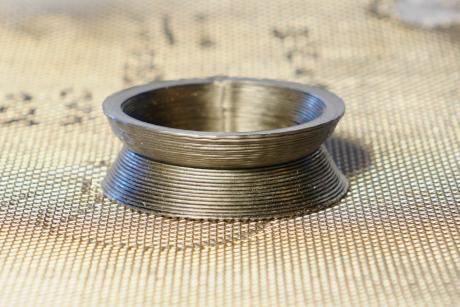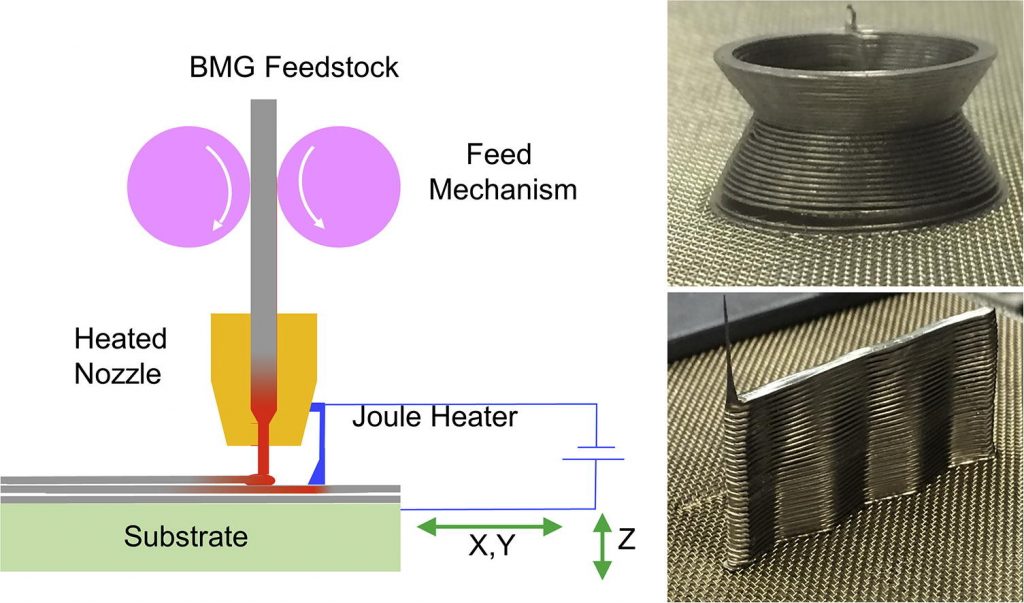A research paper co-authored by researchers at Yale University, MIT and engineers at Massachusetts 3D printer manufacturer Desktop Metal, demonstrates the possibility of 3D printing amorphous metals. When heated, these metals behave more like glass or plastic, meaning they have great potential for use in extrusion-based 3D printing methods.
Recently, Desktop Metal released the next generation of its 3D binder jetting based hardware, the Studio System+, but could amorphous metals/bulk metallic glass (BMG) 3D printing be the next step for the technology unicorn?

The advantages of bulk metallic glasses
BMGs differ from conventional metals in that they have a super-cooled liquid region in their thermodynamic profile. This means that BMGs undergo continuous softening when heated, like common thermoplastics used in Fused Filament Fabrication (FFF). This malleability combined with the high strength of BMGs makes them a promising option for exploration via additive manufacturing, as discussed by Tobias Caspari, head of 3D Printing at Heraeus New Businesses, one of the first companies to succeed in 3D printing amorphous metals:
“Amorphous metals will change our future,”
“They possess a wide variety of previously incompatible characteristics: They are very strong and yet malleable, as well as harder and more corrosion-resistant than conventional metals.”
By extruding metal rather than using laser sintering from a powder, BMG researchers have also hit on a potentially more cost effective and repeatable process for 3D printing custom metal components.
Desktop Metal 3D prints amorphous metals
In this latest research published in Materials Today the team, which includes Desktop Metal CTO Jonah Myerberg, CEO Ric Fulop, and various members of the company’s materials science and engineering department, has delivered a proof-of-concept for BMG 3D printing.
The process works with a well-characterized amorphous alloy composed of zirconium, titanium, copper, nickel and beryllium, (Zr44Ti11Cu10Ni10Be25).
1 mm/700 mm rods of the ZrTiCuNiBe alloy were extruded at a temperature of 460 °C onto a print bed made from a stainless steel mesh heated to 400 °C. The temperature and composition of the mesh prevents crystallization for up to 1 day. To build up multiple layers, a pulsed Joule heater is used “to locally heat the previously printed layer underneath the nozzle to a temperature similar to the extrusion temperature” and create a bond between them when cooled.
Based on these parameters, the researchers were able to 3D print small samples of BMG, namely a zig-zag block, and two connected rings with an overhang.

As easy as 3D printing plastic
According to Jittisa Ketkaew, co-author of the study and graduate student at Yale, when the 3D printed BMG samples were tested, “We expected high strength in the parallel-to-the-printing orientation, but were very surprised by the strength in the perpendicular orientation.”
For Jan Schroers, Professor of Mechanical Engineering and Materials Science at Yale University and Desktop Metal, Inc., the surprising findings are incredibly promising for future exploration. Professor Schroers concludes, “We have shown theoretically in this work that we can use a range of other bulk metallic glasses and are working on making the process more practical- and commercially-usable to make 3D printing of metals as easy and practical as the 3D printing of thermoplastics.”
“3D printing metals like thermoplastics: Fused filament fabrication of metallic glasses“ is published, open access, in Materials Today. The paper is attributed to Michael A. Gibson, Nicholas M. Mykulowycz, Joseph Shim, Richard Fontana, Peter Schmitt, Andrew Roberts, Jittisa Ketkaew, Ling Shao, Wen Chen, Punnathat Bordeenithikasem, Jonah S. Myerberg, Ric Fulop, Matthew D. Verminski, Emanuel M. Sachs, Yet-Ming Chiang, Christopher A. Schuh, A.John Hart and Jan Schroers.
For more of the latest additive manufacturing research, sign up to the 3D Printing Industry newsletter follow us on Twitter, and like us on Facebook.
On the lookout for new talent or seeking a career change? Search and post 3D Printing Jobs for opportunities and new talent across engineering, marketing, sales and more.
Featured image shows FFF 3D printing BMG rods. Photo © 2018 The Authors. Published by Elsevier.



